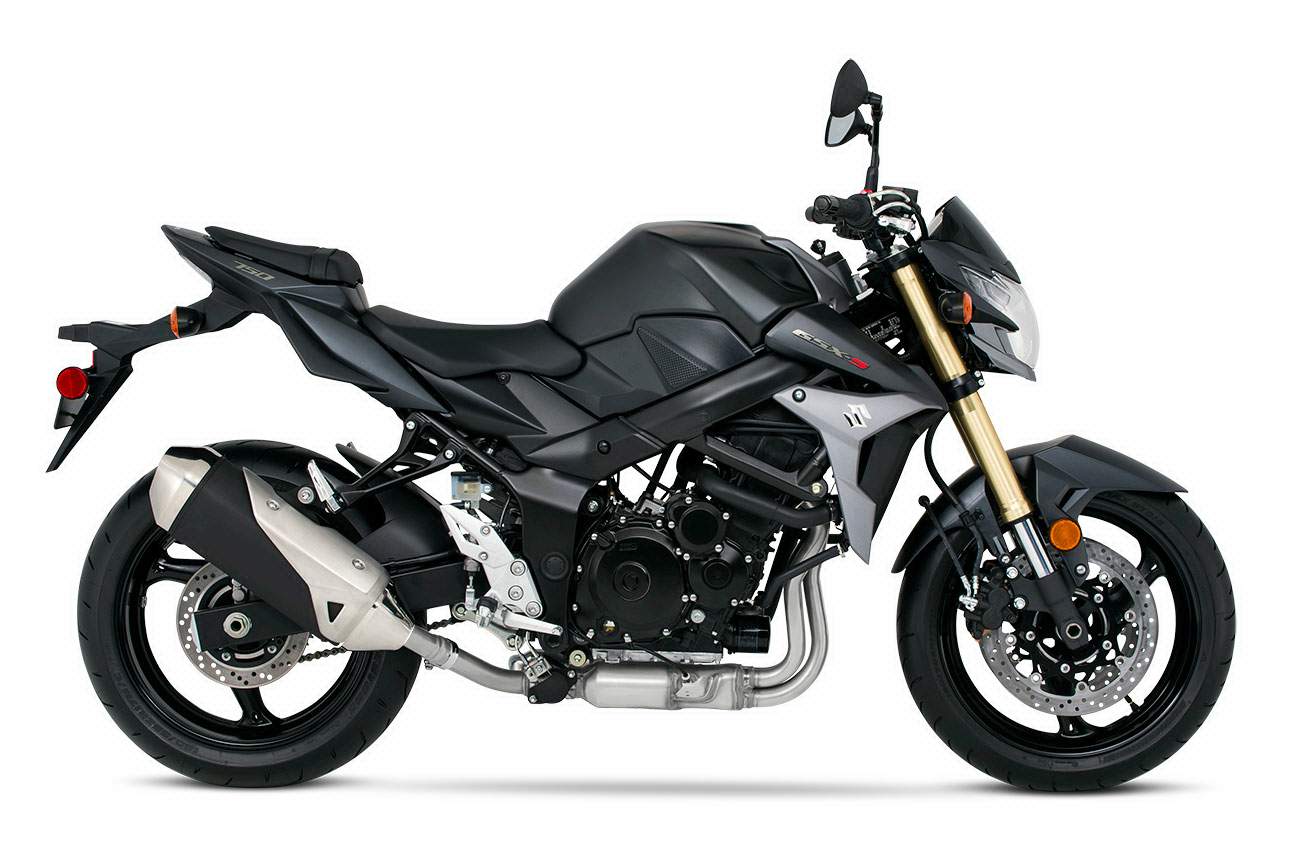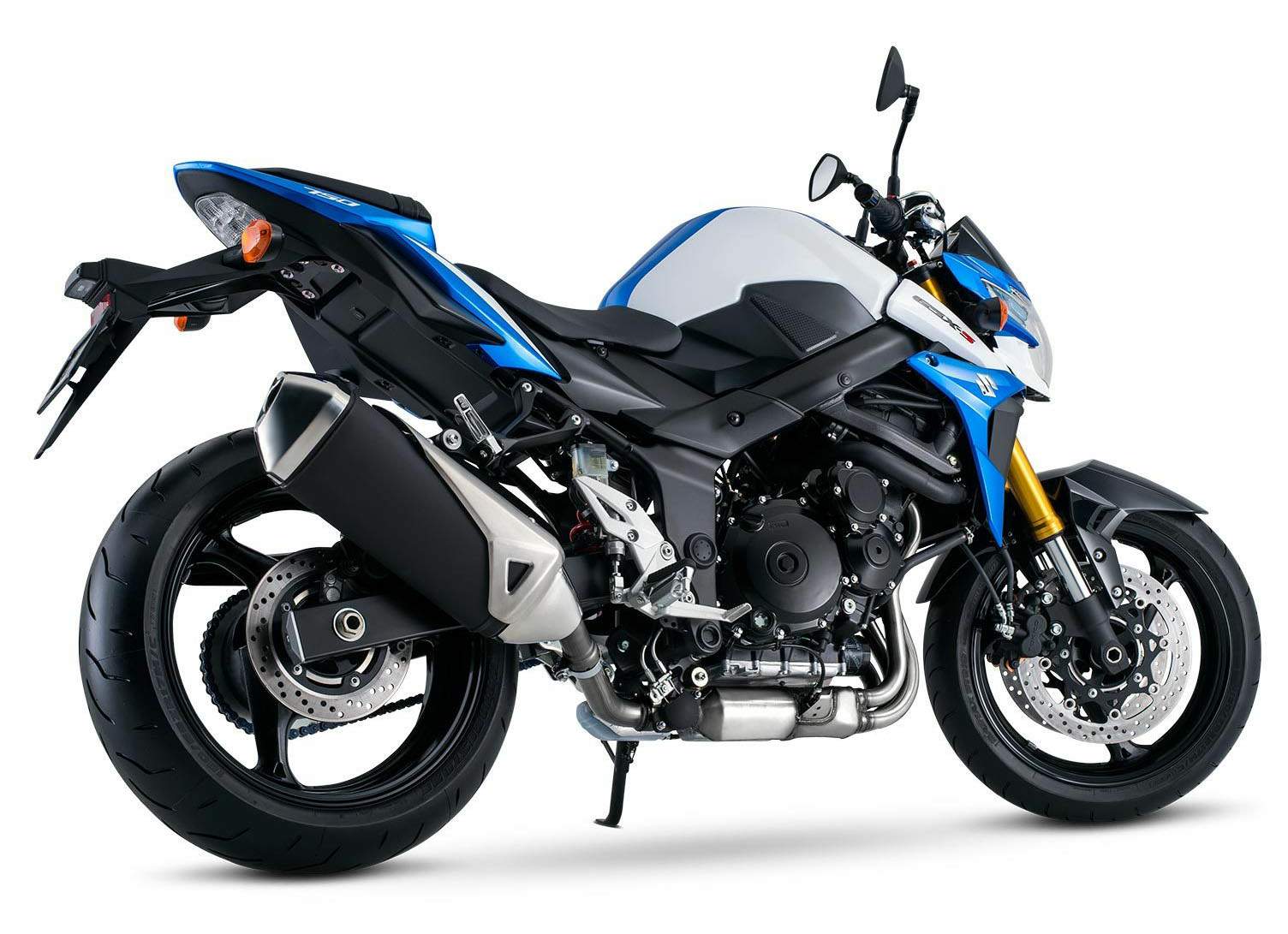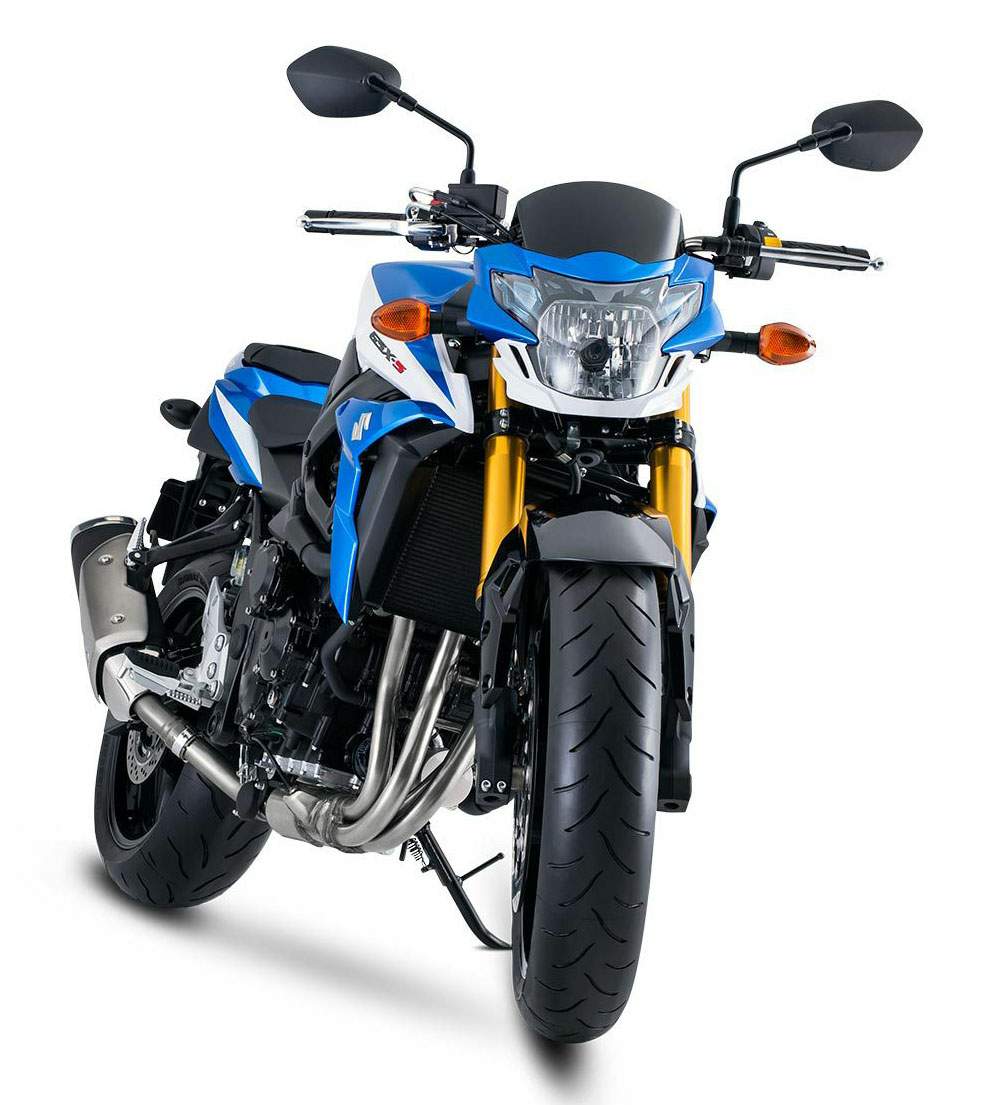
|
|
|
|
|
|
Classic Bikes
Custom Bikes
Individual
Racing Bikes AJP
AJS
Aprilia
Ariel
Avinton / Wakan
Bajaj
Benelli
Beta
Bimota
BMW
Brough Superior
BRP Cam-Am
BSA
Buell / EBR
Bultaco
Cagiva
Campagna
CCM
CF Moto
Combat Motors
Derbi
Deus
Ducati
Excelsior
GASGAS
Ghezzi Brian
Gilera
GIMA
Harley Davidson
Hero
Highland
Honda
Horex
Husaberg
Husqvarna
Hyosung
Indian
Jawa
Kawasaki
KTM
KYMCO
Laverda
Lazareth
Magni
Maico
Mash
Matchless
Mondial
Moto Guzzi
Moto Morini
MV Agusta
MZ / MuZ
NCR
Norton
NSU
Paton
Peugeot
Piaggio
Revival Cycles
Roland Sands
Royal Enfield
Sachs
Sherco
Sunbeam
Suzuki
SWM
SYM
Triumph
TVS
Ural
Velocette
Vespa
Victory
Vincent
VOR
Voxan
Vyrus
Walt Siegl
Walz
Wrenchmonkees
Wunderlich
XTR / Radical
Yamaha
Zero
Video
Technical
Complete Manufacturer List
|
Suzuki GSX-S 750 / ABS
|
| . |
|
Make Model |
Suzuki GSX-S 750 / ABS |
|
Year |
2015 - 16 |
|
Engine |
Four stroke, transverse four cylinder, DOHC, 4 valves per cylinder, TSCC |
|
Capacity |
749 cc / 45.7 cub. in |
| Bore x Stroke | |
| Compression Ratio | 12.3:1 |
| Cooling System | Liquid |
| Lubrication | Wet sump |
|
Induction |
Fuel Injection |
|
Ignition |
Electronic ignition (transistorised) |
|
Starting |
Electric |
|
Max Power |
73.8 kW / 99.1 hp @ 10170 rpm |
|
Max Torque |
73.6 Nm / 54.3 lb-ft @ 9060 rpm |
| Clutch | Wet, multi-plate type |
|
Transmission |
6 Speed, constant mesh |
| Final Drive | Chain, DID50VAZ, 114 links |
| Frame | Aluminium, twin spar |
|
Front Suspension |
Inverted telescopic, coil spring, oil damped |
|
Front Wheel Travel |
120 mm / 4.7 in |
|
Rear Suspension |
Link type, coil spring, oil damped, 7-way adjustable |
|
Rear Wheel Travel |
130 mm / 5.1 in |
|
Front Brakes |
2x 310 mm Full floating discs, 2 piston calipers / ABS |
|
Rear Brakes |
Single 220 mm disc, single pistorn caliper / ABS |
|
Front Tyre |
120/70ZR17M/C (58W) tubeless |
|
Rear Tyre |
|
|
Dimensions |
Length 2115 mm / 83. 2 in Width 785 mm / 30.9 in Height 1060 mm / 41.7 in |
| Wheelbase | 1450 mm / 57.0 in |
| Seat Height | 815 mm / 32.0 in |
| Ground clearance | |
|
Wet Weight |
|
|
Fuel Capacity |
17 Litres / 4.5 US gal / 3.7 Imp gal |
| . |
Blending just the right mix of modern sportbike performance with futuristic streetbike style...
The original Suzuki GSX-R750 was designed as a street-legal bike
that was born on the circuit. The 2015 Suzuki GSX-S750 gives
that championship-winning heritage even more street-smart
performance. Blending just the right mix of modern sportbike
performance with futuristic streetbike style, this 750 is
purpose-built for excitement.
Suzuki took the powerful 749cc four-cylinder fuel-injected
sportbike engine from the GSX-R750, and tuned it to deliver the
perfect power curve for street riding. The engine’s cam profiles
have been revised, and the intake and exhaust tracts have been
reshaped to boost low-end torque and mid-range power. This gives
the 750 unmatched throttle response and intense acceleration.
Suzuki dual-throttle valve fuel injection means the performance
is crisp and consistent.
Handlebars replace the race bike’s clip-ons, delivering a more
upright streetbike style. A complete instrument cluster features
adjustable brightness, plus and analog tachometer, a digital LCD
speedometer, plus a fuel-consumption meter, gear position
indicator, fuel gauge, odometer/trip meter and a clock.
Get a grip on a whole new standard. Striking looks. Comfort.
Power. Versatility. Our standards deliver easy ergonomics,
modern style, and metro muscle in dynamite packages. Whatever
type of riding you prefer, our standards can handle it.
ENGINE FEATURES
Powerful 749cc 4-cylinder fuel-injected engine is tuned to
deliver a dynamic wave of smooth torque and strong acceleration.
Automatic Idle Speed Control (ISC) improves cold starting and
stabilizes engine idle while also reducing cold-start emissions.
Suzuki Exhaust Tuning (SET) servo-controlled butterfly valve
helps enhance torque, response and acceleration, especially at
low-to-mid rpm range.
Throttle bodies with Suzuki Dual Throttle Valve (SDTV) system
contribute to cylinder charging efficiency and combustion
efficiency for better throttle response and torque at the low to
mid rpm range.
State-of-the-art transistorized digital ignition system
contributes to a more complete combustion by igniting the
mixture at the precise instant.
Iridium type spark plugs provide a more condensed and hotter
spark yet last longer.
Effective engine management, emission control systems, and Suzuki Pulsed-secondary AIR-injection (PAIR) system injects fresh air into the exhaust ports together allow the GSR750 to meet the latest emission standards.

CHASSIS FEATURES
Inverted KYB front forks feature a design developed in racing
and that is mandatory on a serious, high-performance machine.
Frame design combines the advantages of a compact tubular girder
streetbike frame and a twin-spar sportbike frame to deliver a
dynamic ride. A sport riding position is created by a carefully
crafted relationship between the handlebars, footrests and seat.
Dual front brakes with fully-floating 310mm discs and
dual-piston calipers. 240mm rear disc brake with single-piston
caliper.
Link-type rear suspension, with a single rear shock absorber
working through a progressive linkage. Spring preload is 7-way
adjustable.
SUSPENSION
Carefully sculpted aggressive front bodywork and side pieces
with highlights including a vented front fender, molded mirrors,
chiseled fuel tank, textured tank side panels, and an angular
tail section with integrated LED taillight. Bright and
distinctively shaped headlight with a 60/55W halogen bulb.
Integrated dual position lights with patterned blue lenses.
A compartment underneath the removable passenger seat can carry
a U-shaped lock or can be used to store small items.
Brightness-controllable instrument cluster, featuring a
prominent analog tachometer and a large, digital LCD speedometer
readout. The LCD display also includes a gear-position
indicator, coolant temperature gauge, fuel gauge, selectable
odometer/dual-tripmeter/fuel consumption meter and a clock.
12-month limited warranty.

Let’s start with the one you don’t know: the new-for-2015 Suzuki GSX-S750. Think of it as a stripped-down GSX-R750, albeit one powered by a retuned 2005-vintage engine. There’s far less plastic on this than its repli-racer forebear, and that slick-looking black frame and swingarm are steel rather than aluminum. Likewise the inverted fork and single shock look trick but have far fewer adjustments than their racier counterparts: Spring preload is it.
Then there’s the bike you do know: the Yamaha FZ-09. Introduced last year, it’s a clean-slate design that borrows neither motor nor chassis from any other model. Unlike the Suzuki, the Yamaha’s frame and swingarm are aluminum, and its fork and shock get adjustable rebound damping in addition to spring preload.
Squint your eyes and the GSX-S resembles nothing so much as the monster B-King, especially in our test bike’s Metallic Matte Black. Suzuki has a long history of making slightly less sporty bikes out of its GSX-Rs, and in many ways the GSX-S continues where the Bandit and Katana lines left off. It would be an exaggeration to call the 750 a parts-bin special, but many of the components do look familiar.
The Yamaha’s angular styling is arguably more modern than the Suzuki’s, accentuated by our testbike’s glowing Cadmium Yellow paint. Moreover, many of the FZ-09’s individual parts are nicer than what you’d expect on a budget-priced naked bike. Our only criticism of its styling is the dash and taillight look like tacked-on afterthoughts. We can live with the unusual slide-type start button, but whoever’s idea it was to position the horn button on the far side of the turn-signal switch should be damned to spend eternity searching for it in traffic!
Throw a leg over the Suzuki and the riding position is immediately familiar. The chicken-splittin’ fuel tank and close-coupled seat and footpegs are pure GSX-R-issue. Thankfully, the chrome-plated, tubular-steel handlebars are higher than a GSX-R’s clip-ons, but they’re fairly narrow, oddly angled, and cheap looking.
The Yamaha sits more like a dirt bike than a streetbike, and its silver-anodized, tapered-aluminum handlebar could have come right off of a YZ450F. The gas tank is super narrow, there’s lots of legroom, and the broad, flat seat, though thin on padding, is comfortable. The only thing lacking is any semblance of wind protection. The Suzuki’s headlight fairing is small but actually deflects a fair amount of wind off of your torso.
The Yamaha is all about power: Its dyno traces are quite similar to the Suzuki’s—just slide the lines up the scale a bit. In terms of peak output, the FZ-09 makes 5 more ponies and 5 more pound-feet of torque, but it boasts as much as 15 more pound-feet of torque below 5,000 rpm. That, friends, is instant-on power, to the point of some herky-jerkiness, especially in the most aggressive of the three engine power modes. Response from the ride-by-wire throttle on first-year FZ-09s was poor, but it’s noticeably better this year.
That low-end grunt means the Yamaha wheelies at will—in fact, it feels more like an open-classer than a middleweight. In contrast, the Suzuki feels more like a 600, requiring copious revs and clutch slippage to get it up.
To the Suzuki’s credit, it makes predictable, linear power, and its gearbox is ultra-slick-shifting. And while neither of these machines is what we’d call dead smooth, they aren’t marred by debilitating vibration either. The Suzuki tingles; the Yamaha buzzes.
Both bikes need improvement in suspension action. The Yamaha is undersprung and underdamped, its fork bottoming when the front brakes are squeezed with any urgency. The Suzuki is the exact opposite: It’s way overdamped, resulting in a buckboard ride. Speaking of brakes, the Suzuki employs two-piston, single-action front calipers that lack initial bite compared to the Yamaha’s four-piston jobs. Neither bike is currently available with ABS, but that could change soon as the European Union makes it a requirement on all streetbikes beginning next year.
Taking a quick glance at the specs, the Yamaha boasts 100cc more displacement than the Suzuki yet weighs 40 pounds less—credit its three-cylinder engine and aluminum chassis. The FZ-09 also rules in quarter-mile times and top-gear roll-ons. Fuel mileage is a virtual tie, as is price: The Yamaha costs $200 more than the black Suzuki but just $50 more than the blue/white version. The only category where the Suzuki comes out on top is top speed: 140 versus 130 mph, the Yamaha’s being electronically limited.
And that, in a nutshell, is how this comparison went down: It really was no contest. Unless you’re a diehard Suzuki fan on your way to or from a GSX-R, you’d get a lot more satisfaction out of owning the Yamaha. Not only does the FZ-09 offer greater performance than the GSX-S750, but it’s more capable, more comfortable, and a whole lot more fun. Simply put, no other streetbike available today offers as much bang for the buck.
Source cycleworld.com

|
Any corrections or more information on these motorcycles will be kindly appreciated. |